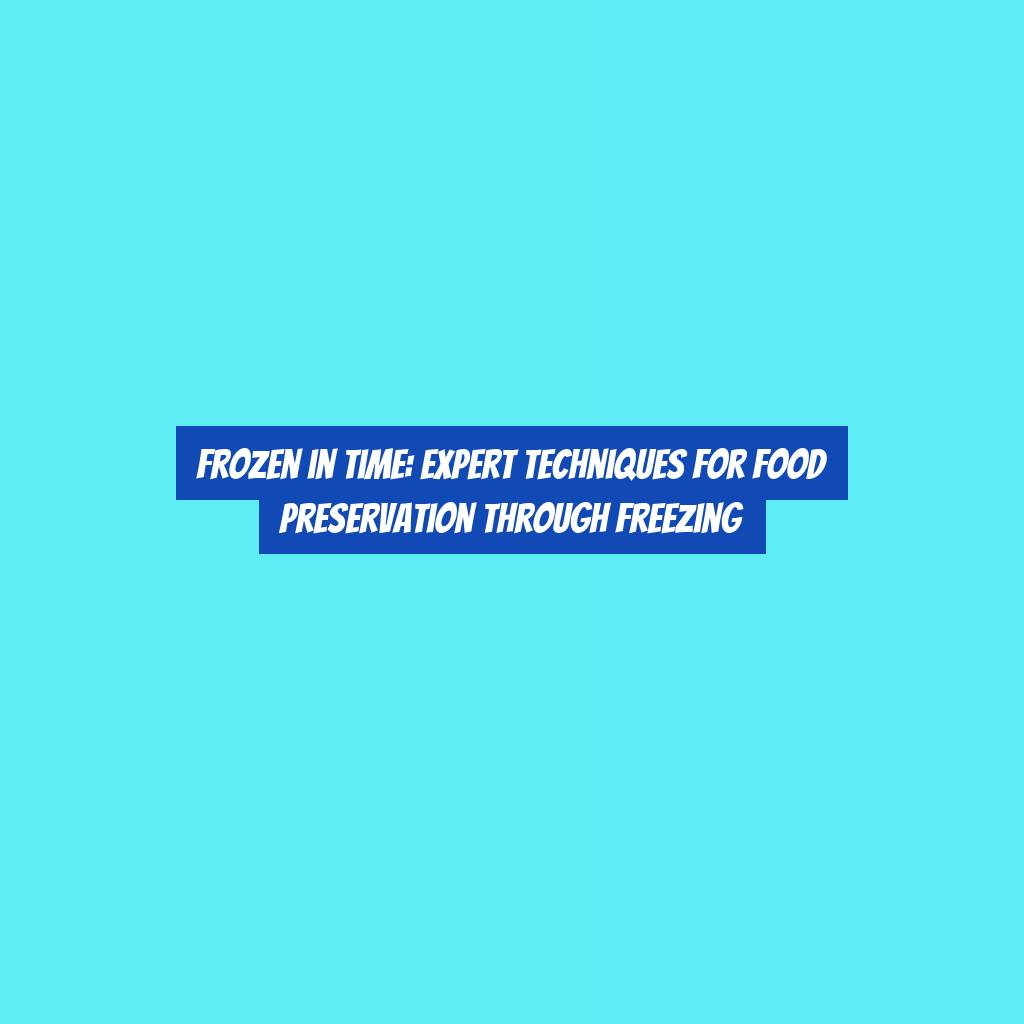Frozen in Time: Expert Techniques for Food Preservation through Freezing
Torn between wanting to savor the taste of summerG??s ripe berries and needing to avoid food waste? Freezing is your answer.
But before you stash everything in the freezer, itG??s essential to understand the expert techniques for food preservation through freezing. From choosing the right containers to mastering the art of thawing, there are crucial steps that can make all the difference in preserving the flavors and nutrients of your favorite foods.
Whether youG??re a seasoned home cook or just starting to explore the world of food preservation, these techniques will elevate your freezing game and ensure you always have a taste of the season at your fingertips.
Choosing the Right Containers for Freezing
When freezing food, itG??s important to choose the right containers to ensure maximum freshness and quality. Opt for containers made of rigid, durable materials such as plastic, glass, or heavy-duty aluminum foil. These materials help protect your food from freezer burn and prevent the absorption of odors from other items in the freezer.
Make sure the containers have a tight seal to keep out air, which can cause freezer burn and compromise the taste and texture of your food. Additionally, select containers that are the right size for the amount of food you plan to freeze, leaving a little room at the top to allow for expansion as the food freezes. This will help prevent the containers from cracking or bursting.
Label your containers with the contents and the date of freezing to keep track of whatG??s in your freezer and ensure that you use the oldest items first. By choosing the right containers for freezing, you can preserve the quality of your food and enjoy delicious, fresh-tasting meals even after theyG??ve been frozen.
Preparing Foods for Freezing
To ensure optimal results when freezing food, itG??s essential to properly prepare the foods before placing them in the freezer. Start by cleaning and trimming the food, removing any spoiled or damaged areas.
For fruits and vegetables, blanching is crucial to preserve their color, flavor, and nutritional value. After blanching, ensure rapid cooling by immersing them in ice water.
For meats, trim excess fat and divide into meal-sized portions for easier thawing and serving.
Proper packaging is key to prevent freezer burn and maintain quality. Use airtight containers or freezer bags, removing excess air to minimize the risk of freezer burn. Label each package with the contents and date to keep track of freshness.
When dealing with liquids, leave some headspace in the container to allow for expansion during freezing. Remember to cool foods to room temperature before freezing to avoid raising the temperature in the freezer.
Maximizing Freezer Space and Organization
Consider arranging your frozen items strategically to maximize the available space and make it easier to access different items when needed.
Start by using stackable containers or bags to store items like soups, sauces, and stews. ItG??s also helpful to invest in some clear plastic bins or baskets to group similar items together. This makes it easier to find what you need without having to dig through the entire freezer.
Utilize the door space for smaller items like frozen fruit, butter, or pre-portioned bags of vegetables. Take advantage of vertical space by using shelves, bins, or hanging racks to store smaller items like bags of frozen berries or homemade snacks.
Additionally, consider labeling and dating your frozen items to keep track of what you have and when it was frozen. Lastly, prioritize the items you use most frequently by placing them in easily accessible areas.
Understanding Freezing Techniques and Temperatures
To effectively preserve food through freezing, itG??s essential to understand the specific techniques and temperatures required for different types of food items. Freezing techniques vary depending on the food being preserved.
For fruits, itG??s important to use a method such as flash freezing, where the fruit is spread out on a tray and frozen quickly to prevent clumping. Vegetables, on the other hand, often benefit from blanching before freezing to preserve their color and texture.
Understanding the optimal freezing temperatures is crucial. The recommended temperature for most frozen foods is 0-?F (-18-?C) or lower, as this inhibits the growth of microorganisms and slows down enzyme activity, maintaining the quality of the food.
When it comes to freezing techniques, itG??s important to consider packaging as well. Air-tight, moisture-proof packaging is essential to prevent freezer burn and maintain the quality of the food. Remember to label packages with the date of freezing to keep track of freshness.
Thawing and Using Frozen Foods
Now that you understand the optimal freezing techniques and temperatures for different types of food, itG??s important to know the best practices for thawing and using your frozen foods. Proper thawing is crucial to maintain the quality and safety of your frozen items.
Here are some expert tips to help you make the most of your frozen foods:
-
Thawing Techniques:
-
Refrigerator: This is the safest method for thawing most foods. Place the frozen item in the fridge and allow it to thaw slowly. It may take some time, but this method preserves the texture and flavor of the food.
-
Cold Water: For a quicker thaw, submerge the tightly sealed food in cold water. Change the water every 30 minutes to ensure it stays cold. This method is suitable for items that need to be used soon after thawing.
-
Using Frozen Foods:
-
Refreezing: Once thawed, avoid refreezing raw meats and seafood unless theyG??ve been cooked. However, many fruits and vegetables can be refrozen after proper cooking or processing.
-
Cooking: Utilize your frozen ingredients in cooking. Frozen fruits are great for smoothies and baking, while frozen vegetables can be used in soups, stews, and stir-fries.
Conclusion
So, next time you have an abundance of fresh produce or leftovers, remember these expert techniques for food preservation through freezing.
By choosing the right containers, preparing foods properly, maximizing freezer space, and understanding freezing techniques and temperatures, you can ensure that your frozen foods stay fresh and delicious.
And when itG??s time to use them, donG??t forget to thaw them properly for best results.
Happy freezing!

